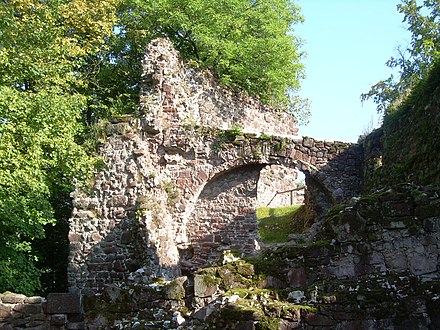Nordhausen is a Kreis (district) in the north of Thuringia, Germany. Neighboring districts are : Harz and Mansfeld-Südharz in Saxony-Anhalt; Kyffhäuserkreis and Eichsfeld in Thuringia; and Göttingen and Goslar in Lower Saxony.

Nordhausen is a city in Thuringia, Germany. It is the capital of the Nordhausen district and the urban centre of northern Thuringia and the southern Harz region; its population is 42,000. Nordhausen is located approximately 60 km north of Erfurt, 80 km west of Halle, 85 km south of Braunschweig and 60 km east of Göttingen.
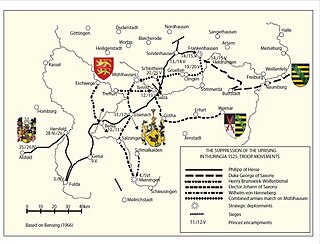
The Battle of Frankenhausen was fought on 14 and 15 May 1525. It was an important battle in the German Peasants' War and the final act of the war in Thuringia: joint troops of Landgrave Philip I of Hesse and Duke George of Saxony defeated the peasants under their spiritual leader Thomas Müntzer near Frankenhausen in the County of Schwarzburg.

Ilfeld is a village and a former municipality in the district of Nordhausen, in Thuringia, Germany. It is situated at the south foot of the Harz, at the entrance to the Bährethal, 8 miles (13 km) north from Nordhausen by the railway to Wernigerode. Since 1 January 2012, it has been part of the municipality of Harztor.
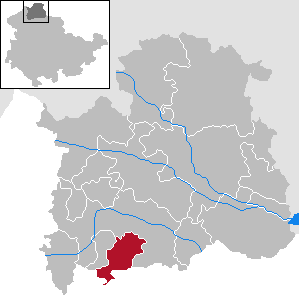
Großlohra is a municipality in the district of Nordhausen, in Thuringia, Germany, situated on the northern edge of the Hainleite ridge about 20 km southwest of the district capital. It consists of the settlements of Friedrichslohra, Großwenden, Kleinwenden, as well as Münchenlohra with its former convent basilica St. Gangulphus and castle Lohra with its accompanying manor, all of which were united in 1950.
Hohnstein/Südharz is a former Verwaltungsgemeinschaft in the district of Nordhausen, in Thuringia, Germany. The seat of the Verwaltungsgemeinschaft was in Ilfeld. It was disbanded in July 2018.

The County of Stolberg was a county of the Holy Roman Empire located in the Harz mountain range in present-day Saxony-Anhalt, Germany. It was ruled by a branch of the House of Stolberg.
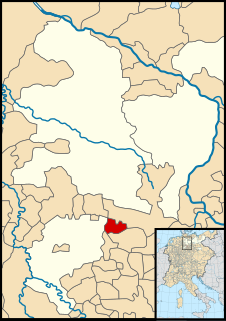
The County of Wernigerode was a state of the Holy Roman Empire which arose in the Harzgau region of the former Duchy of Saxony, at the northern foot of the Harz mountain range. The comital residence was at Wernigerode, now part of Saxony-Anhalt, Germany. The county was ruled by a branch of the House of Stolberg from 1429 until its mediatization to the Kingdom of Prussia in 1806. Nevertheless, the county remained in existence - with one short interruption - until the dissolution of the Kingdom of Prussia in 1918.

The Poppenberg is a tree-covered hill east of Ilfeld in the Harz mountains of Germany, with a height of 601 metres. Since 1897, there has been a 33-metre-high (108 ft) steel lattice observation tower on the summit. The tower was built by the Nordhausen branch of the Harz Club and was named after Otto, Prince of Stolberg-Wernigerode. In good weather, it has an extensive view over the South Harz, the Goldene Aue and the Kyffhäuser.

The Alter Stolberg is a wooded karst plateau, up to 357.7 m above sea level (NN), in the South Harz in Central Germany. It lies in the districts of Nordhausen in the state of Thuringia and Mansfeld-Südharz in the state of Saxony-Anhalt.
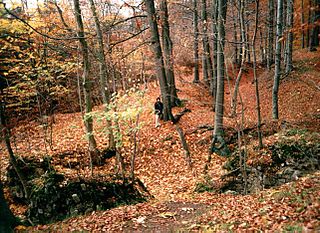
The Erichsburg, formerly Erichsberg, is a ruined medieval castle near the village of Friedrichsbrunn in the Harz Mountains in central Germany. It is located within the boundaries of Gernrode, a part of Quedlinburg.

Hasserode Castle in the quarter of the same name in the town of Wernigerode am Harz was a medieval fortification whose site is near Hasserode station on the Harz Narrow Gauge Railways. Today there are no visible traces left of the castle.

Sophienhof is a village in the municipality of Ilfeld in the district of Nordhausen in the German federal state of Thuringia.

Harztor is a municipality in the district of Nordhausen, in Thuringia, Germany. It was formed on 1 January 2012 by the merger of the former municipalities Ilfeld and Niedersachswerfen. In July 2018 the former municipalities of Harzungen, Herrmannsacker and Neustadt/Harz were merged into Harztor.

The Imperial Castle of Kyffhausen is a medieval castle ruin, situated in the Kyffhäuser hills in the German state of Thuringia, close to its border with Saxony-Anhalt. Probably founded about 1000, it superseded the nearby imperial palace (Kaiserpfalz) of Tilleda under the rule of the Hohenstaufen emperors during the 12th and 13th centuries. Together with the Kyffhäuser Monument, erected on the castle grounds between 1890 and 1896, it is today a popular tourist destination.
The Barony of Bilstein was a dynastic lordship with extensive estates in the region of the present German states of Hesse and Thuringia.
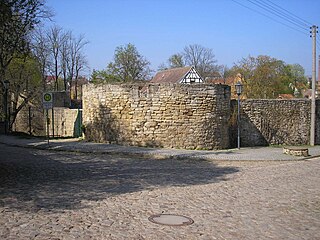
Schkölen Castle is a partially preserved water castle stand at a height of 210 metres above sea level (NN) in the centre of the town of Schkölen in the county of Saale-Holzland-Kreis in the German state of Thuringia. Until 1977 the ruins of the water castle lay almost forgotten and overgrown with briars in the middle of the little town.

Limberg Castle is a ruined hill castle on the 190-metre-high Limberg in the Wiehen Hills. It is located near the village of Börninghausen in the borough of Preußisch Oldendorf in the East Westphalian county of Minden-Lübbecke in the German state of North Rhine-Westphalia.
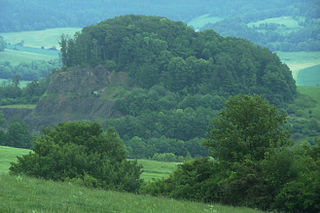
Fischberg Castle was a high medieval fortification in the Felda valley that was sited on an exposed hill above the villages of Klings, Fischbach and Diedorf. Its ruins currently stand in the county of Wartburgkreis (Thuringia) - in the Anterior Rhön, part of a mountain region in central Germany.


